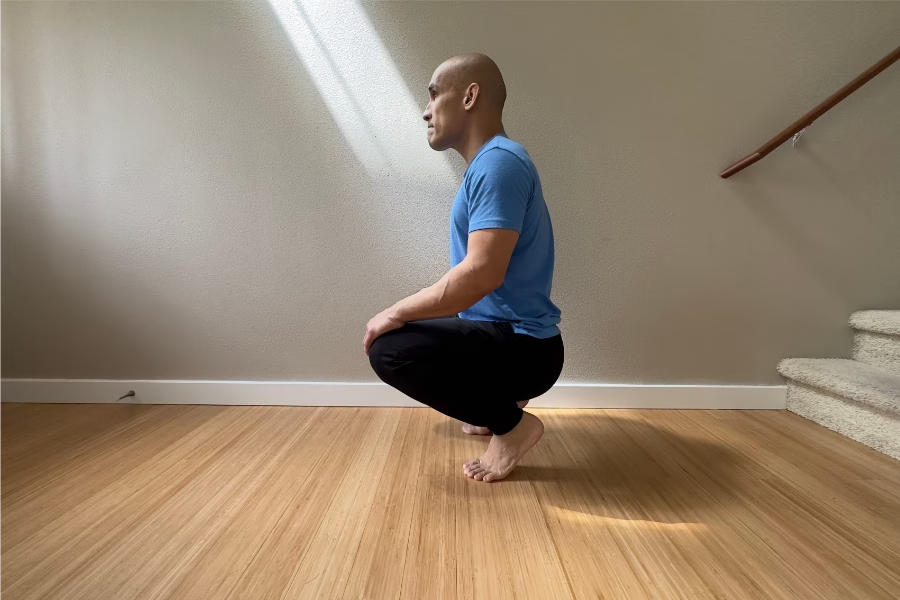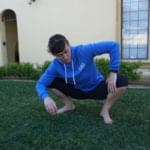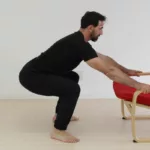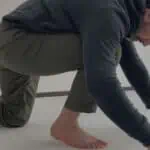So your heels pop up when you squat. Every fitness influencer says this is “wrong.”
Here’s why that’s bullshit…
 If you’re training smart and working on mobility but your heels still come up in deep squats, you’re not broken.
If you’re training smart and working on mobility but your heels still come up in deep squats, you’re not broken.
I see this fixation all the time. Everyone wants the Instagram-perfect squat with heels glued down. But squatting with heels up isn’t dangerous. Your body is made to move in a wide variety of different ways.
The real question isn’t “How do I fix my broken squat?”
It’s “How do I work with what I’ve got right now while building toward what I want?”
Here’s how.
Heels Come Up When Squatting? Here’s How to Fix It:
Most people assume this is a mobility issue, but there’s more to it…
In the video, Ryan (yes, squatting strong at 52!) shows you:
- A 30-second test to see what’s really limiting your squat
- Why your ankles may not be the culprit
- The key movement we use in Elements to build the hip strength and control your squat needs: the Frogger.
And here’s something interesting: your ankles might not be the real problem.
They could be protecting you from what’s actually missing, hip strength and control.
That’s why if you’ve already done endless ankle stretches they may not have helped out much.
👉 This is exactly why Frogger is part of our Elements program.
It builds the strength, mobility, and motor control that carry over to everything you do, not just squats.
Why it works: Every rep builds hip mobility, core strength, and squat mechanics all at once.
How to start: Hold the deepest squat you can (heels up is fine). Then add hands forward for balance and progress toward the Frogger.
What to expect: In 2–3 weeks, most people notice their squat feels deeper, stronger, and more stable, all without forcing ankle stretches.
Don’t Get Stuck – Here’s How To Keep Moving:
Just because we (or whoever you’re learning from) demonstrate a movement in a particular way doesn’t mean it has to be exactly that way.
Yes, you’re working towards the positions you see in the demo, but just because you can’t do it the way you see it on screen doesn’t mean you can’t work on the movement right now.
There’s always ways you can adjust the movements for your needs. For example:
- Bear: You can keep the knees bent. No problem at all.
- Frog: You can keep the heels up, widen your stance, or turn the toes out.
- Monkey: Similar to the frog you can adjust your leg positioning. And if you have trouble getting your palms to the floor, you can tent your fingers or ball your hands into fists (if you have the wrist strength).
Please remember, there are always adjustments you can make so you can train and practice right now.
There is absolutely no need to wait until everything is “perfect”!
Perfect Squat Form: Myth or Reality?
People talk a lot about the “perfect squat.” Feet flat, back straight, hips low, everything in neat alignment.
Peep our bodyweight squat tutorial for a more complete guide to basic squat form and mobility.
“Perfect” sounds nice, but there’s no one single perfect way to squat.
And trying to force yourself into a one-size-fits-all version often causes more problems than it solves.
For example, is it ideal to have your feet flat?
Arguably, keeping your soles in firm contact with the floor creates more stability in the ankles, knees and hips, allowing you to express your leg and hip strength more fully. Such as in the case of wanting to squat as much weight as possible or more simply, just want to be safe and steady while you are shifting side to side.
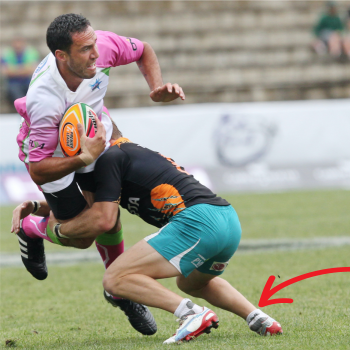 The shifting side to side happens all the time in sports and other activities where you have to change directions laterally and even backwards a bit. Basketball, football, soccer, or even scrambling down hill in a hike. At least one foot flat on the ground is a big help there!
The shifting side to side happens all the time in sports and other activities where you have to change directions laterally and even backwards a bit. Basketball, football, soccer, or even scrambling down hill in a hike. At least one foot flat on the ground is a big help there!
But in squats for exercise and training, it’s not necessary.
At this point you might be saying, “But isn’t it dangerous to squat low if the heels lift?”
Is It Safe to Squat With Heels Up? (Short Answer: Yes)
A lot of people worry that lifting the heels in a squat is dangerous. The reality? It’s usually fine, especially with bodyweight squats. If you’re loading up a barbell and trying to squat ass-to-grass, you may be too unstable to get that low without tweaking something. But generally speaking, no.
For regular training and practice, squatting with heels up is simply another way your body explores movement. In fact, some squat variations (like the sissy squat) require heels up by design.
Your body is meant to move in a variety of ways.
 Now we’re not suggesting that you absolutely need to do such an intense squat variation. The point is that doing regular deep squats, even with your heels up, makes sure you aren’t limiting your practice.
Now we’re not suggesting that you absolutely need to do such an intense squat variation. The point is that doing regular deep squats, even with your heels up, makes sure you aren’t limiting your practice.
This allows you to explore your full capabilities in your hip and knee range of motion and teaches you how to move in this position.
Let’s get real: We are not often doing “perfect squats” throughout our daily lives, so there can be payoffs to practicing different ways of squatting.
To that point, you can still benefit from doing squats by limiting your depth to just before the heels want to pop up. This can teach you how to move better in that position — how you need to shift your weight and adjust your upper and lower body. It can also give you a benchmark of where you are at right now in terms of your strength and mobility and how they’ll improve over time.
Your hip, knee, ankle and foot flexibility will gradually get better as you continue to practice. So in short, make time in your routine to practice squatting as deeply as you can even if that means your heels are up, and also squatting as deeply as you can with your feet flat.
Developing your own movement routine shouldn’t be about performing skills and movements in the “optimal way.” It’s about figuring out how best to move with the body and skill you have right now, and as a result, gaining more options of how you uniquely move.
This mentality is a big part of physical autonomy.
More Exercises to Help You Keep Your Heels Down in Squats
There are a variety of factors that can affect your ability to squat deeply with your heels flat:
- Hip, back, knee, and ankle mobility
- Overall strength
- Coordination
- Motor control
Your individual restrictions could be rooted in one area or a mix, this is why it’s best to approach it from different angles and explore!
What can you do about this?
- Keep practicing squat variations like in the videos above
- Explore different accessory exercises and see where they lead you
Since we got you covered on the first point, try these next few exercises and see how they feel, you might get an “aha!” moment.
Rock Back Variations
The idea of these is to rock forward and back between the balls of your feet and your heels.
Start with your hands on the ground and your hips up high so that your heels are flat already, then drop down to right where your heels start to rise up.
You can do this with staggered legs like in a squat lunge or in the A-Frame.
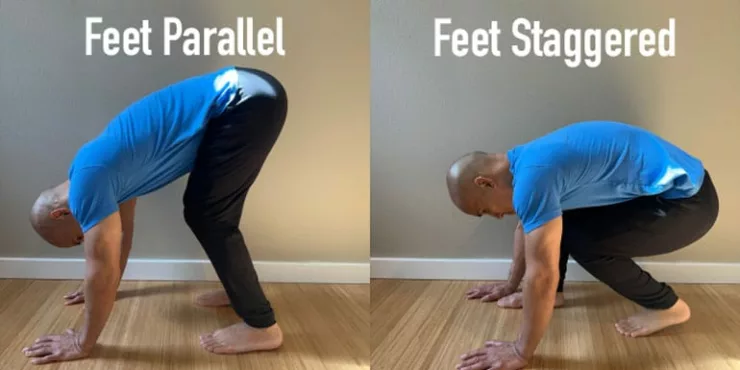
Explore for 1-2 minutes.
You can play with shifting your weight side-to-side as well and front-to-back and see how your ankles feel in different positions.
Wall Squats
 As the name suggests, stand with your back against the wall and sit into as deep of a squat as you can, then stand back up.
As the name suggests, stand with your back against the wall and sit into as deep of a squat as you can, then stand back up.
If your wall is too sticky or friction-y you can place a medicine or exercise ball behind your back to help you roll down.
The key here is to get your center of gravity behind your heels a bit so you’re able to drop further down than in squatting without support. This change in positioning is enough to give you a different awareness of how you are squat. Explore for 1-2 minutes.
Bent Knee Ankle Stretch
 This can be a great stretch for your hips or ankles, depending on which you would like to emphasize.
This can be a great stretch for your hips or ankles, depending on which you would like to emphasize.
If you are focusing on the hips: keep the front shin vertical as you shift the pelvis forward and open up the hips.
For the ankle: Keep the front heel on the ground as you shift the knee forward and increase ankle flexion. Whichever one you choose, do 5-10 dynamic contractions before holding the stretch for 20-30 seconds.
Integrating These Drills for a Deeper Squat
The cool thing is: these exercises don’t have to take up large chunks of your training session. Only spend a few minutes on them either in your prep or cool down.
In fact, you can do these throughout the day as they make great movement breaks. Don’t be afraid of weirding out your co-workers at the water cooler. Overall, find a position that’s good for you (meaning, you’re not in pain) feel what’s going on in your body and work at a pace feels doable.
Working on your squat is great. But when you practice with a system that also builds hip strength, ankle mobility, and core control, you don’t just squat better, you move better in every part of life.
That’s why we built Elements: a proven, step-by-step method that helps thousands of people go from stiff and stuck to strong, mobile, and capable.
If you’re ready for squats that feel good and carry over into the rest of your training and daily life, Elements is the next step.
Build Squats That Carry Over
Our Elements program doesn’t just improve your squat; it trains the strength, mobility, and control that make all your movement feel better.
